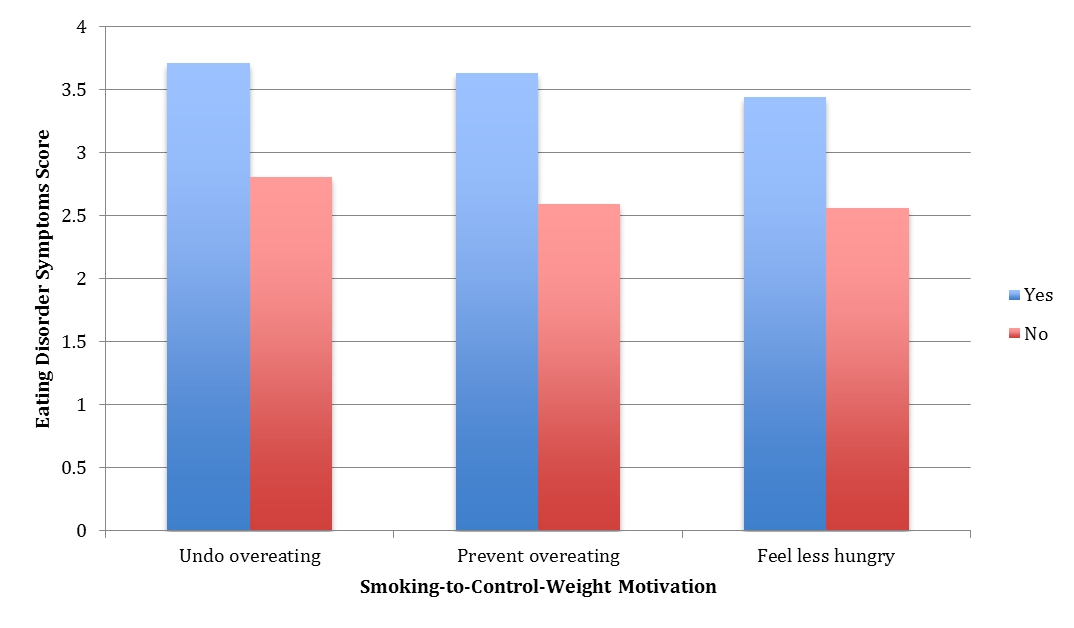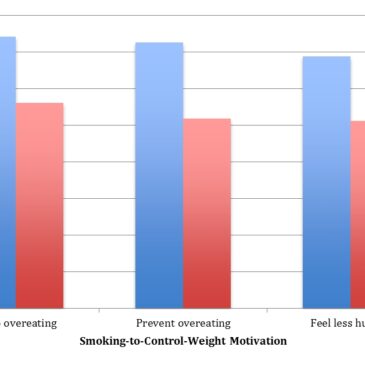Many women smoke based on a belief that smoking helps to control weight (Camp, Klesges & Relyea, 1993; John, Meyer, Hapke, Rumpf, & Schumann, 2004). Today, as most Americans prepare for a big Thanksgiving feast, ASHES reviews a study that examines if using smoking as a mean to control weight is a general phenomenon, or is more likely to be found among those who have unhealthy relationship with food, as evidenced by binge eating and eating disorder symptoms (White, 2012).
Methods
- The researchers recruited 107 adult female current smokers via national Craigslist ads using advertisements that invited volunteers to participate in a study on health behaviors, dieting and weight and weight control
- The researchers collected data on the relationship between smoking and eating. Specifically, researchers asked about the following:
- Smoking to undo the effects of overeating (i.e., “When you overeat, do you smoke more afterward?”)
- Smoking to prevent overeating (i.e.,“ Do you smoke to prevent overeating?”)
- Smoking to control hunger (i.e., “Do you smoke to feel less hunger?”)
- Participants also indicated the frequency of smoking to control weight by answering the question, “Over the past four weeks (28 days), on how many days have you smoked cigarettes as a means of controlling your shape or weight?”
- The researchers explored how these factors were related to past-month frequency of binge eating episodes and eating disorder symptoms measured from an eating disorder questionnaire.[1]
Results
- Women who smoked more to undo the effects of overeating reported significantly more binge eating episodes (N = 27, mean = 7.2, standard deviation = 10.4) compared to women who did not (N = 80, mean = 2.0, standard deviation = 4.0).
- Figure 1 shows the total eating disorder symptom score for those who reported smoking to undo the effects of overeating, prevent overeating, and feel less hunger, as compared to those who did not. Those who answered affirmatively to these questions had significantly higher eating disorder symptom scores.
- Women who smoked more frequently as a form of weight control had significantly higher eating disorder symptom scores (r = .37).
 Figure. Total eating disorder symptom score as a function of response to eating and smoking questions (adapted from White, 2012). Click image to enlarge.
Figure. Total eating disorder symptom score as a function of response to eating and smoking questions (adapted from White, 2012). Click image to enlarge.
Limitations
- Тhe authors relied on self-reported data on smoking and eating behaviors, as well as height and weight. This is a limitation because participants might have provided inaccurate reports about their smoking and eating habits and feelings..
- This study does not establish causality. It can determine whether smoking to control weight causes binge eating or whether binge eating (and potentially other eating disorder symptoms) cause women to use smoking as a weight control tool.
- The sample of participants who responded to the ad that advertised a study about weight and dieting can be biased. For example, women who responded to the Craigslist ad might have been more interested in dieting in general, and more interested in using smoking as a mean for weight control in particular, than women who did not respond to the ad.
Conclusions
Women who reported smoking to control weight had more symptoms of eating disorders and engaged in binge eating more frequently than those who did not. To further understand the relationship, it is important that future studies investigate patterns of smoking and eating behaviors across time; only such prospective study can determine causal can temporal associations. For now, it might be best to put the cigarettes away and enjoy your Thanksgiving dinner. Happy Thanksgiving!
–Julia Braverman
References
Camp, D. E, Klesges, R. C, & Relyea, G. (1993) The relationship between body- weight concerns and adolescent smoking. Health Psychology 12(1), 24-32.
John, U., Meyer, C., Hapke, U., Rumpf, H. J., & Schumann, A. (2004) Nicotine dependence, quit attempts, and quitting among smokers in a regional population sample from a country with a high prevalence of tobacco smoking. Prevention Medicine, 38(3), 350-358.
Fairburn C. G. & Beglin S. J. (1994) Assessment of eating disorders: interview or self-report questionnaire? International Journal of Eating Disorder, 16(4), 363-70.
White, M. (2012). Smoking for weight control and its associations with eating disorder symptomatology. Comparative Psychiatry, 53(4), 403 – 407
What do you think? Please use the comment link below to provide feedback on this article.
________________
[1] The Eating Disorder Examination-Questionnaire (EDE-Q; Fairburn, & Beglin, 1994) measures frequency of binge eating episodes (i.e., eating unusually large amounts of food while experiencing a sense of loss of control over the eating) and purging as well as dietary restraint, eating concerns, weight concerns, and shape concern. It also provides as well as an overall score, which is reported in this review.




